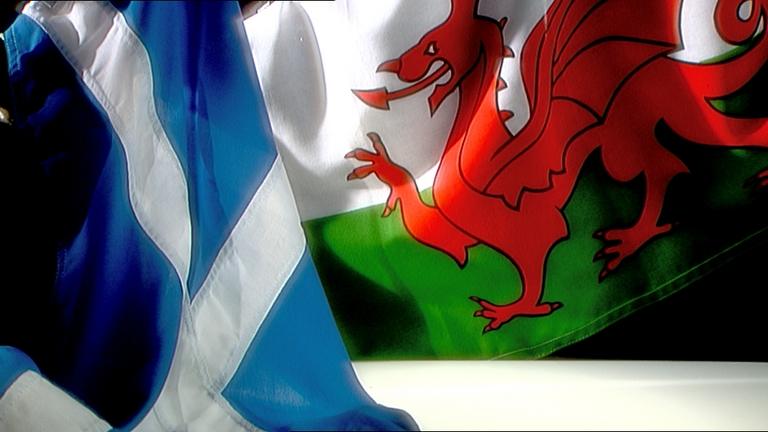Scotland's referendum: Eight things that connect Scotland and Northern Ireland
- Published
The coasts of Northern Ireland and Scotland are only about 12 miles apart, so it is not surprising that the two countries have had a close relationship over the years.
On a recent visit to Ireland to discuss future collaboration, the Scottish government's external affairs secretary, Fiona Hyslop, said: "The fact that the most recent figures show almost 55,000 Irish people live in Scotland and almost 18,000 Scots live in Ireland illustrates the enduring nature of the ties between the countries."
A shared history, geographical proximity and cultural ties, whether it be through Gaelic or Scots heritage, has ensured an enduring commonality between the Scots and Northern Irish.
In the second of a three part series looking at Scotland's relationship with other parts of the UK, we take facts that connect the two nations.

1. National icons
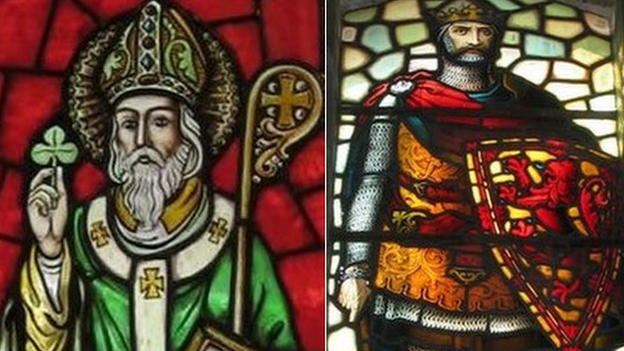
A number of ancient churches in Scotland claim to have been founded by St Patrick, while Robert the Bruce had links to Ireland
While St Patrick is indisputably Ireland's patron saint, and Robert the Bruce is one of Scotland's national heros, it seems that both nations may be able to lay some claim to the historical figure associated with the other.
It is thought that Bruce may have had his famous encounter with the spider in a cave on Rathlin Island, off the coast of County Antrim, which was reputed to have been owned by his Irish mother.
And while the story goes that St Patrick was brought to Ireland as a teenage slave, some have claimed he was originally Scottish and was born at Kilpatrick, near Dumbarton, in 387 AD.

2. A long history of immigration
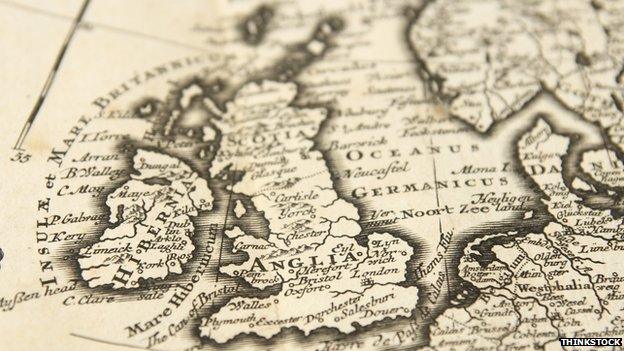
Scotia, or "kingdom of the Gaels", was the Roman name for Ireland, but in the Middle Ages it also came to refer to Scotland, with Ireland known as Scotia Maior, and Scotland as Scotia Minor
Long before the first Plantation of Ulster in the 1600s there was a very close connection between Ulster and Scotland.
It is believed that the very first settlers in Ireland came via Scotland some 10,000 years ago during the Mesolithic period.
Ireland then decided to invade bits of Scotland, and historians think that this is in fact how the name Scotland came about, with Scoti the name given to Irish raiders and bandits who attacked Roman Britain.

3. Gaelic

Britain's earliest native census, Senchus fer nAlban, which listed the population of Dalriada, dates from the 7th Century
It is thought that Gaelic culture, including the Gaelic tongue, was brought to Scotland in the Middle Ages by Fergus Mor, who led an expedition to Scotland from County Antrim.
He founded the Kingdom of Dalriada, which comprised most of the West of Scotland along with counties Antrim and Down.
While the Irish Gaelic and Scots Gaelic languages are now distinct, they remain part of the same dialect and individual words and phrases remain similar enough that an Irish speaker and a Scottish Gael could reach mutual understanding without much effort.

4. Scots culture
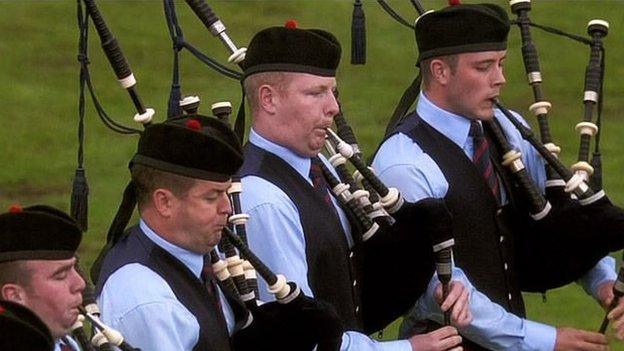
The Field Marshall Montgomery Pipe Band from Lisburn, outside Belfast, are the current World Pipe Band Champions
While Ireland gave Scotland its Gaelic culture, Scotland returned the favour in the 16th and 17th centuries when thousands of Lowland Scots poured into Ulster, bringing many aspects of Scottish culture to Ireland.
Lowland Scots speech was introduced to Ulster at the beginning of the 17th Century, becoming Ulster-Scots, which is today considered both a language and dialect.
According to the 2011 census, it is still spoken by about 8% of the population of Northern Ireland.
Bagpiping is another Scottish import that many in Northern Ireland have readily taken to and excelled at, with a band from Northern Ireland having won the World Pipe Band Championships for the past three years.

5. Banknotes
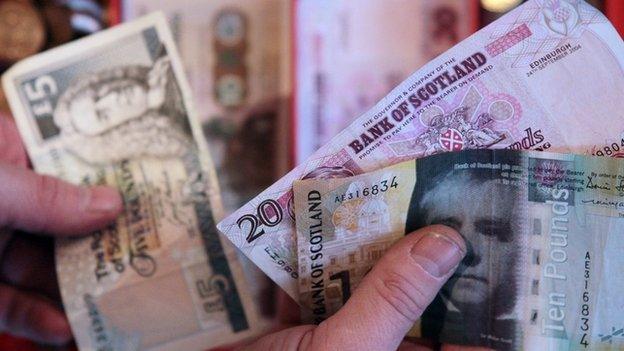
English comedian Michael McIntyre has joked about trying to use Scottish bank notes in his comedy stand up set
Within the realm of day to day gripes and grievances there are few things that annoy Scots more than having their Clydesdale, RBS or Bank of Scotland £20 note refused in England.
So much so in fact that the problem of trying to pay a London taxi driver with a Scottish note was brought up by an audience member in the recent TV debate between Alex Salmond and Alistair Darling.
Those in Northern Ireland can readily sympathise given that four banks in Northern Ireland - Ulster Bank, Bank of Ireland, First Trust and Dankse Bank (formerly Northern Bank) - all issue their own banknotes.

6. Sport
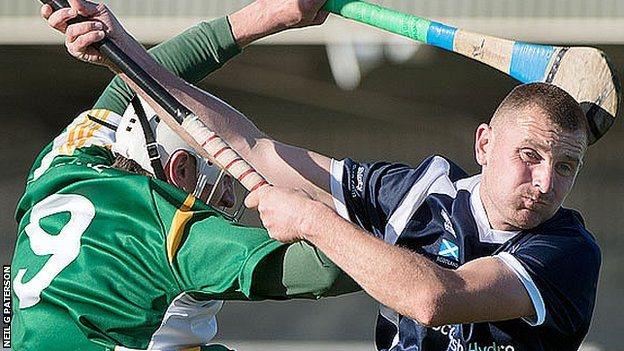
Northern Ireland hurling teams compete at All-Ireland and county level, while shinty is played mainly in the Highlands of Scotland
While Irish hurling and Scottish shinty differ both in rules and the number of players on a team, they were once the same sport, with hurling having been brought to Ireland by the Celts.
The Gaels then in turn brought the sport with them to Scotland, where it evolved into what it now known as shinty.
The similarities between the two games have allowed for the creation of a hybrid sport known as shinty-hurling, which uses a combination of the rules of both sports in order to make international matches between shinty and hurling players possible.

7. Shipbuilding
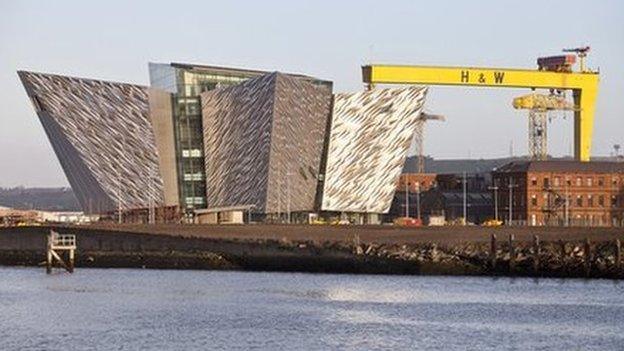
Shipbuilding work in Belfast has largely dried up and the shipyard has been turned into a Titanic visitors centre
The Clyde shipyards produced some of the great industrial steamers and warships of the 19th and 20th centuries, while Harland and Wolff's shipyard in Belfast gave us the Titanic.
But Harland and Wolff also made an impression in Scotland, buying several shipyards in Govan before the outbreak of World War One.
Taking advantage of an abundance of skilled workers, they specialised in building tankers and cargo ships - in sharp contrast to the luxurious passenger liners they were known for - and later expanded their operations in Glasgow, where they remained until the 1960s when the company decided to consolidate its operations in Belfast.

8. Whisky
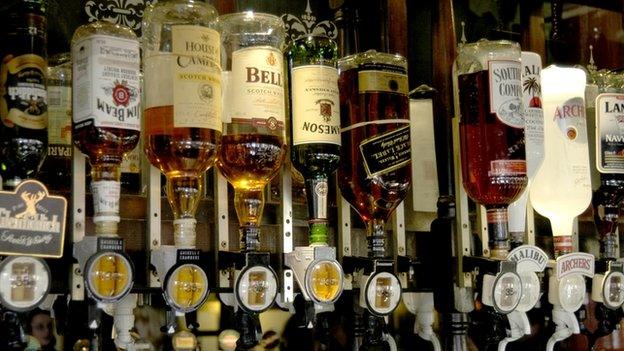
Nowadays American, Canadian and Japanese whisky brands are competing with the best of Scottish and Irish offerings
They might spell it differently, with the Irish whiskey having an 'e', but it is one of the biggest exports for both countries, with brands such as Ballantines, Bells and Bushmills known worldwide.
Both countries lay claim to having invented it, and the debate over who first came up with the famous tipple has been raging since the Dark Ages.
But whether you spell it whisky or whiskey, or even opt for uisge beatha (the Gaelic name meaning ''water of life''), there can be no doubt that this is one export that the inhabitants of both nations are extremely fond and proud of.
- Published8 May 2014
